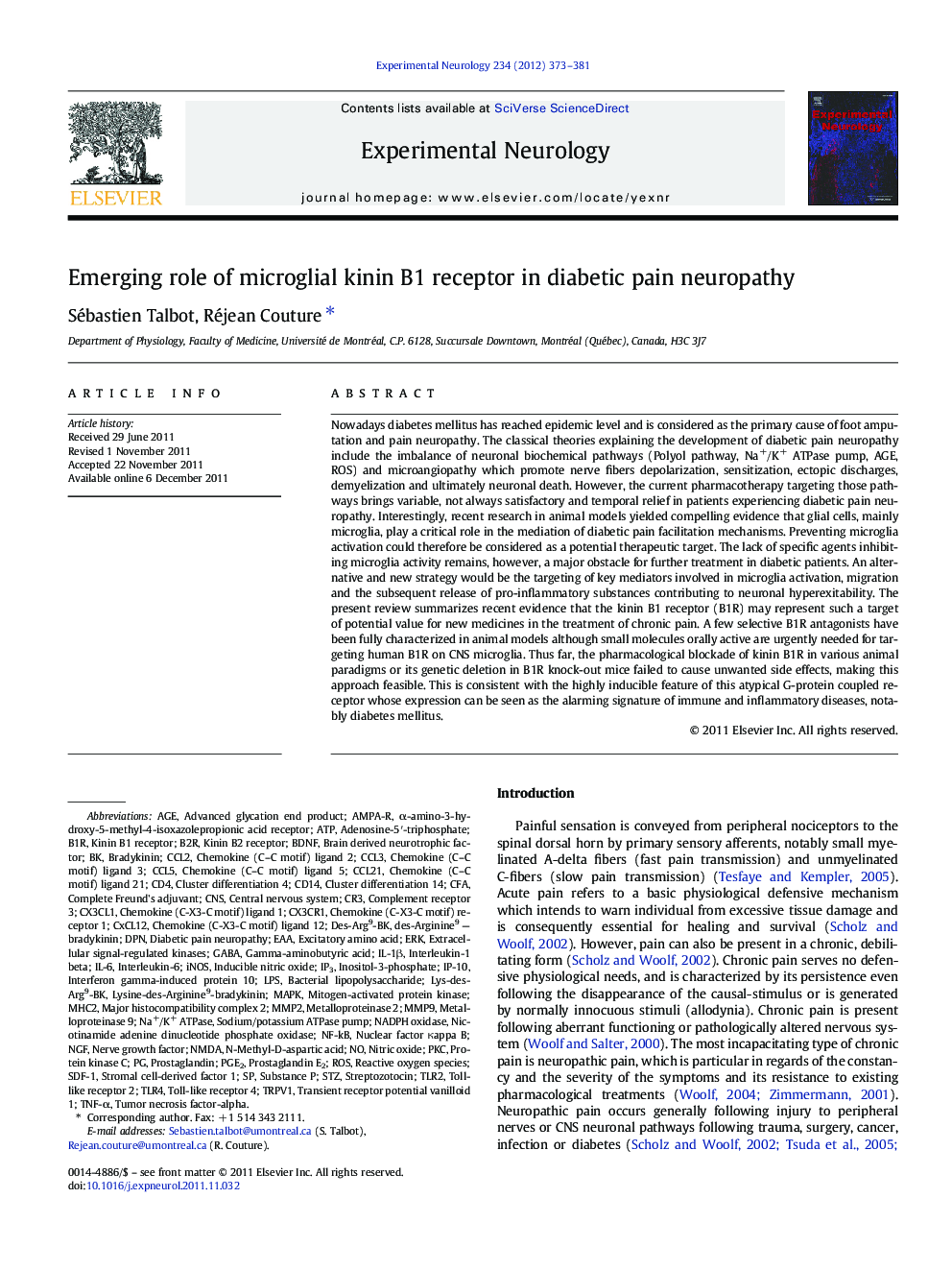| کد مقاله | کد نشریه | سال انتشار | مقاله انگلیسی | نسخه تمام متن |
|---|---|---|---|---|
| 6018801 | 1186528 | 2012 | 9 صفحه PDF | دانلود رایگان |
عنوان انگلیسی مقاله ISI
Emerging role of microglial kinin B1 receptor in diabetic pain neuropathy
دانلود مقاله + سفارش ترجمه
دانلود مقاله ISI انگلیسی
رایگان برای ایرانیان
کلمات کلیدی
MMP9IL-1βNGFIP3NMDATLR2EAAPKCDPNCcl5AMPA-RCX3CR1N-methyl-d-aspartic acidCD14CXCL12TLR4STZCD4CCL21IP-10CCL3MMP2CX3CL1CR3B2Rchemokine (C–C motif) ligand 5B1RKinin B2 receptorDes-Arg9-BKchemokine (C-X3-C motif) ligand 1Inositol-3-phosphateCFASDF-1PGE2LPSTRPV1IL-6NF-kBiNOSERKCCL2complete Freund's adjuvant - adjuvant دوست کاملBDNF - BDNF یا فاکتور نورونزایی مشتقشده از مغز MAPK - MAPKNa+/K+ ATPase - Na + / K + ATPaseROS - ROSα-amino-3-hydroxy-5-methyl-4-isoxazolepropionic acid receptor - α-amino-3-hydroxy-5-methyl-4-isoxazole propionic acid receptoradenosine-5′-triphosphate - آدنوزین 5'-تری فسفاتATP - آدنوزین تری فسفات یا ATPexcitatory amino acid - آمینو اسید هیجان انگیزstreptozotocin - استرپتوزوتوسینgamma-aminobutyric acid - اسید گاما آمینو بوتیریکinducible nitric oxide - اکسید نیتریک القا کنندهNADPH oxidase - اکسیداز NADPH interleukin-6 - اینترلوکین ۶Interleukin-1 beta - اینترلوکین-1 بتاbradykinin - برادیکینینtumor necrosis factor-alpha - تومور نکروز عامل آلفاCNS - دستگاه عصبی مرکزیAge - سنcentral nervous system - سیستم عصبی مرکزیstromal cell-derived factor 1 - عامل مشتق از استروما 1brain derived neurotrophic factor - عامل مغز استخوان مغز استخوان استnerve growth factor - فاکتور رشد عصبTNF-α - فاکتور نکروز توموری آلفاBacterial lipopolysaccharide - لیپوپلی ساکارید باکتریاییSubstance P - ماده PMetalloproteinase 9 - متالوپروتئیناز 9Nitric oxide - نیتریک اکسیدnicotinamide adenine dinucleotide phosphate oxidase - نیکوتین آمید آدنین دیونوکلئوتید فسفات اکسیدازTransient receptor potential vanilloid 1 - پتانسیل گیرنده گذرا وانیلیوئید 1interferon gamma-induced protein 10 - پروتئین ناشی از گاما اینترفرون 10Protein kinase C - پروتئین کیناز سیmitogen-activated protein kinase - پروتئین کیناز فعال با mitogenProstaglandin E2 - پروستاگلاندین E2prostaglandin - پروستاگلاندینهاadvanced glycation end product - پیشرفته محصول نهایی گلیساسیونchemokine (C–C motif) ligand 2 - کیموکین (C-C motif) لیگاند 2extracellular signal-regulated kinases - کیناز های تنظیم شده سیگنال خارج سلولیGABA - گاباReactive oxygen species - گونههای فعال اکسیژنKinin B1 receptor - گیرنده B1 کینینToll-like receptor 2 - گیرنده تله مانند 2Toll-like receptor 4 - گیرنده تله مانند 4Complement receptor 3 - گیرنده تکمیلی 3
موضوعات مرتبط
علوم زیستی و بیوفناوری
علم عصب شناسی
عصب شناسی
پیش نمایش صفحه اول مقاله

چکیده انگلیسی
Nowadays diabetes mellitus has reached epidemic level and is considered as the primary cause of foot amputation and pain neuropathy. The classical theories explaining the development of diabetic pain neuropathy include the imbalance of neuronal biochemical pathways (Polyol pathway, Na+/K+ ATPase pump, AGE, ROS) and microangiopathy which promote nerve fibers depolarization, sensitization, ectopic discharges, demyelization and ultimately neuronal death. However, the current pharmacotherapy targeting those pathways brings variable, not always satisfactory and temporal relief in patients experiencing diabetic pain neuropathy. Interestingly, recent research in animal models yielded compelling evidence that glial cells, mainly microglia, play a critical role in the mediation of diabetic pain facilitation mechanisms. Preventing microglia activation could therefore be considered as a potential therapeutic target. The lack of specific agents inhibiting microglia activity remains, however, a major obstacle for further treatment in diabetic patients. An alternative and new strategy would be the targeting of key mediators involved in microglia activation, migration and the subsequent release of pro-inflammatory substances contributing to neuronal hyperexitability. The present review summarizes recent evidence that the kinin B1 receptor (B1R) may represent such a target of potential value for new medicines in the treatment of chronic pain. A few selective B1R antagonists have been fully characterized in animal models although small molecules orally active are urgently needed for targeting human B1R on CNS microglia. Thus far, the pharmacological blockade of kinin B1R in various animal paradigms or its genetic deletion in B1R knock-out mice failed to cause unwanted side effects, making this approach feasible. This is consistent with the highly inducible feature of this atypical G-protein coupled receptor whose expression can be seen as the alarming signature of immune and inflammatory diseases, notably diabetes mellitus.
ناشر
Database: Elsevier - ScienceDirect (ساینس دایرکت)
Journal: Experimental Neurology - Volume 234, Issue 2, April 2012, Pages 373-381
Journal: Experimental Neurology - Volume 234, Issue 2, April 2012, Pages 373-381
نویسندگان
Sébastien Talbot, Réjean Couture,